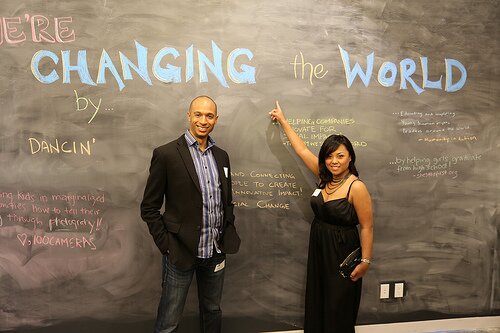Why Collaboration Matters: The Platform for Social Innovation 2
By Tim Draimin, Executive Director of Social Innovation Generation (SiG) National
- Tim is facilitating a SEWF 2013 session called “Social Innovation Labs.”
- SiG is an organizing partner for SEWF 2013.
- People that enjoy this article may wish to check out the SEWF 2013 program streams “Social Innovation” and “Collaboration.”
- This article originally appeared on the SiG blog, a great resource for articles on social innovation. The feature picture is courtesy of Fast Company.
I recently attended an extremely worthwhile conference, Accelerate: Collaborating for Sustainability, organized by the Canadian branch of The Natural Step. The conference proposed new ways for dramatically shifting gears in how we reach sustainability by reaching for levers that will drive systems change.
My role was to moderate a panel entitled “Why Collaboration Matters: Exploring Collective Impact and Shared Value.” The two presenters were Avrim Lazar, a tri-sector athlete who is the former CEO of the Forest Products Association of Canada and a prime mover of the historic Canadian Forest Boreal Agreement, and David Hughes, CEO of Pathways to Education and a visionary in gold standard scaling out and scaling up. The following are my introductory remarks at the Accelerate conference:
Several months ago, evaluation expert Michael Quinn Patton observed that collaboration is like teenage sex:
- Everyone is talking about it,
- Everyone thinks everybody is doing it, and
- In reality, nobody is doing it very well.
If the bad news is nobody is doing it very well, the good news is that collaboration is a topic whose time seems to have arrived.
Last week my inbox was stuffed with collaboration articles boasting headlines like:
- Collaboration: the fuel for innovation (HuffPost)
- Scaling up cross-sector collaboration: what are the challenges? (Guardian)
- Forging Ahead with Cross-Sector Innovations (SSIR)
I come from the field of social innovation: using a simple definition, social innovations are new ideas meeting unmet needs. They are social in their means and social in their ends. SiG uses a more complete definition of social innovation courtesy of our colleague, Frances Westley:

Frances Westley
“Social innovation is an initiative, product, process or program that profoundly changes the basic routines, resource and authority flows or beliefs of any social system. Successful social innovations have durability and broad impact.”
Given how so many major social and environmental indicators are not performing well; think of biodiversity, climate change or aboriginal educational achievement or social inclusion. There is a growing market for social innovations. Recent research on successful social innovations is teaching us that collaboration is an essential element of effective innovation. As my SiG colleagues Michele-Lee Moore and Frances Westley explain in a recent article for Ecology and Society, there is a direct correlation between social innovations expanding their boundary spanning reach and those innovations’ heightened impact:
Michele-Lee Moore and Frances Westley
“Complex challenges demand complex solutions. By their very nature, these problems are difficult to define and are often the result of rigid social structures that effectively act as ‘traps’… Therefore when a social innovation crosses scales, the innovation is crossing a boundary that separates organizations, groups, hierarchical levels or social sub-systems, whether they are economic, cultural, legal, political, or otherwise. The more boundaries that the innovation crosses, the wider and possibly deeper the impact, and the more likely the result is more transformative change.”
Boundary spanning action is often made possible by boundary spanning collaborations, partnerships, and culture. Unfortunately, the antiquated systems we operate in often impede collaboration. British innovation writer Charles Leadbeater wrote a recent paper entitled “It’s Cooperation, Stupid”:

Charles Leadbeater
“Humans are more cooperative than other species because we are capable of more fine-grained forms of cooperation: we are prepared to cooperate with strangers, over large distances and times, overcoming obstacles of language and culture. This deeply wired capacity for cooperation will be more important than ever to enable us to create shared solutions to complex challenges, from global financial regulation to ageing and climate change. Yet most of our systems, institutions and models of public policy lock us in to a miserable, impoverished view of ourselves as untrustworthy and selfish. These approaches actively crowd out cooperation, supplanting cooperative solutions with systems that rely on material incentives. They remake the world in their own image.”
My SiG colleague Tim Brodhead frequently speaks about there being four drivers for collaboration:
To those I’d add a fifth:
These drivers are five lenses that we can use to view the challenges of introducing innovation with collaborative platforms. In upcoming posts I’ll review learning opportunities available to foster collaborative partnerships, as well as examine success stories to uncover their rich innovation DNA.

About Tim Draimin:
Tim Draimin is ED of Social Innovation Generation (SiG) (partnership of McConnell Family Foundation, Toronto’s MaRS innovation hub, University of Waterloo, SiG West) supporting accelerated strengthening of Canada’s Social Innovation ecosystem. SiG’s programs address Canadians’ ability to innovate to overcome large scale complex social and environmental challenges through new forms of problem solving via cross-sectoral partnerships and social innovation labs. SiG convened the Canadian Task Force on Social Finance, proposing a seven-point agenda for mobilizing private capital for public good. Tim authored Canada’s first national study of social entrepreneurship, is co-author of a new study on corporate social innovation and is a frequent advisor to government, non-profit associations and business. He is a member of governance or advisory boards of Trico and Catherine Donnelly Foundations, Partnership Brokers Association, Grand Challenges Canada, Youth Social Innovation Fund, and Centre for Impact Investing.






